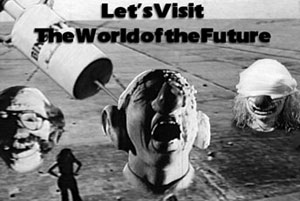 This brilliant three-quarters-hour film (preferrable to the thirty-minute version) Let's Visit the World of the Future (1973) is narrated by control-freak Mr. Camera, & shot in a style that is is a very warped version of a vintage black & white newsreel or old industrial film. This brilliant three-quarters-hour film (preferrable to the thirty-minute version) Let's Visit the World of the Future (1973) is narrated by control-freak Mr. Camera, & shot in a style that is is a very warped version of a vintage black & white newsreel or old industrial film.
Mr. Camera brings us a report from the future where the ruling elite are called Bozos because they're literally clowns, some of them crossbred with humans to achieve ever more grotesque hybrids. They commit cruel acts against anyone with a lingering semblance of humanity or dissatisfaction.
Decades ahead of the torture-porn craze, this is one sick little dystopian science fiction nightmare. Director Douglass Smith becane better known as the Reverand Ivan Stang of the Church of the Subgenius, a religion that likewise represents a satiric dystopian vision as though viewed from the 1950s.
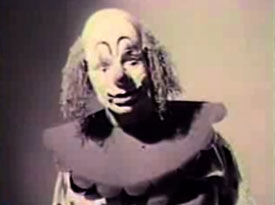 Within that faith, the future coming of a master race of Bozos is a fundamental teaching, so unlikely as it seems, Let's Visit the World of the Future is a religious film. Within that faith, the future coming of a master race of Bozos is a fundamental teaching, so unlikely as it seems, Let's Visit the World of the Future is a religious film.
We're informed that the holographic world is every bit as delightful as "the real trees & mountains & sunsets of the dark past."
What we see holographically is a wasteland of tract homes & strip malls inspired by "the Mediocratines of the middleclass ages" whose art & architecture, suburbs & franchises, power plants & office buildings. was "the most relaxing & appeasing of all art forms."
The narration is cheerfully instructional, as we see a banal world of illusion with Bozos enforcing everything people are permitted to see or buy or experience. If the holographic illusions go off-line, the lights are put out so no one will see in what they really live, & instructed to regard it a privilege to experience such spur of the moment eclipses.
The actual environment is a giant apartment complex covering the entire surface of the world. The roof is an endless plain of concrete.
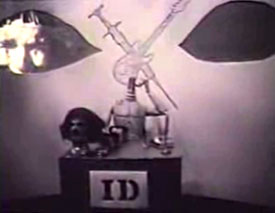 Everyone has their own assigned "unit for eunichs" which we might call bachelor apartments. Anyone who balks at the system in any manner is beaten by roving gangs of Bozos. Everyone has their own assigned "unit for eunichs" which we might call bachelor apartments. Anyone who balks at the system in any manner is beaten by roving gangs of Bozos.
Since clowns enjoy spreading fun & there's nothing more fun than a savage beating, they will also select innocent obedient individuals at random & beat them near to death.
With elements possibly borrowed from THX 1138 (1971), this is a world of drugged slavery, mind-dullingly violent entertainment on television, & unutterable sexlessness. Shopping is also an important past time, & always concludes with one's daily purchases flushed down a toilet.
The population is injected with Nuclear Beer five times a day which keeps them inudstrious & tractible, & makes everyone mature faster; the eldest citizens are twenty-five, when they are instructed to kill themselves, which act they invariably perform with religious obedience.
Repopulation is achieved through a population of permanently comatose broodmares. They offspring are kept in a trance state & indoctrinated sublminally until old enough to work. "And now children, it's time for recess. Please rolle up your sleeves."
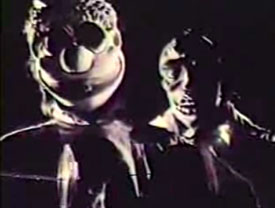 When these offspring are awakened at age twelve, they immediately become effective laborers with twenty-hour workdays seven days a week. When these offspring are awakened at age twelve, they immediately become effective laborers with twenty-hour workdays seven days a week.
Everyone in this equal opportunity world performs identically at machines that produce energy to operate the next machine; nothing practical or useful is generated, because that is done on another floor of the complex by self-replicating robots.
There's also a bit of creepy animation, drawn & stop-motion, as for a sequence showing the inner workings of the mind. There are even claymation Martians. One stop moton sequence shows Barbies & Kens on a murderous rampage of rape & slaughter, with a stop-motion Bozo hacking up up a bloody Ken.
God (Hugh M. Smith) has a very strange talk show that reveals the nature & purpose of the universe, which will come to an end if he ever wakes up. And we meet the Emperor Hiatt, who has the form of a rock that speaks banal aphorisms like "Nobody's perfect."
There's an hysterical segment on sadistic, rape-oriented Bozo mating rituals, founded on the theory "If they're old enough to bleed, they're old enough to breed." Life is hell not just for the humans, but also for the cruel policing force of Bozos, but they don't care, because they're clowns, & "The clown who cries gets the pies."
A work of genius (as well as Subgenius), Let's Visit the World of the Future is one of the best dystopian visions on film, satiric, horrific, witty, & truly demented, as well as a pioneering contribution to the whole genre of psycho clown movies.
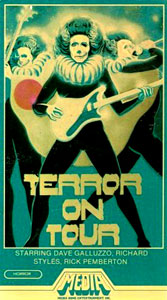 In the would-be-comedy horror fiasco Terror on Tour (1980), the Clowns are heavy metal rockers of mediocre or worse talent who were inspired by Kiss to dress as clowns.
In the would-be-comedy horror fiasco Terror on Tour (1980), the Clowns are heavy metal rockers of mediocre or worse talent who were inspired by Kiss to dress as clowns.
The director made horror films mostly sold on video in adult bookstores into the early '90s by which time the web put an end to most such stores. Mostly these weren't even good enough for the exploitation grindhouses so quite conceivably never showed on big screens anywhere ever.
The psycho-clowns rock group's on-stage horror-theatrics spill out into the real world when someone in clown costume begins picking off teen groupies.
It's an absolutely awful movie with such poor lighting that much of the time you can't make out what's going on, not that there's really any mystery about it.
I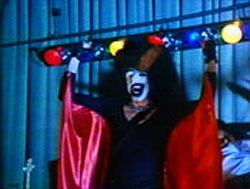 n 1980 there cearly was an audience, however small, that just wanted to see some girls' boobs then see the dirty sluts punished via brutal slayings -- & Terror on Tour was these pervs' idea of sexy. n 1980 there cearly was an audience, however small, that just wanted to see some girls' boobs then see the dirty sluts punished via brutal slayings -- & Terror on Tour was these pervs' idea of sexy.
By now most of those guys are probably serving twenty to life without access to their favorite movies any more.
Quite a few heavy metal horror films were made in the early '80s, none that I've seen any better than this one.
It should be needless to say this example is by no means worth tracking down, but there are horror fans on the eternal quest for something even worse than the last worst film they ever saw, & Tour of Terror is a good choice for such comparisons.
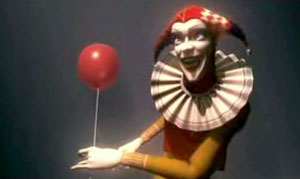 An exceedingly well designed three-dimensional animated short, less than four minutes in length, is Balloon (2004), produced at the Ringling School of Art & Design.
An exceedingly well designed three-dimensional animated short, less than four minutes in length, is Balloon (2004), produced at the Ringling School of Art & Design.
A girl lays unconscious on a lonely street after a car crashes into a pole. She seemingly awakens in a spotlight on a wooden floor, surrounded by darkness. Into the light steps a spooky jester-clown, mutely attempting to seduce her into thinking of him as somehow appealing or amusing.
He mimes a bit of magic, producing a small red balloon by sleight of hand. The girl seems to know she had better not take the balloon from the jester's hand.
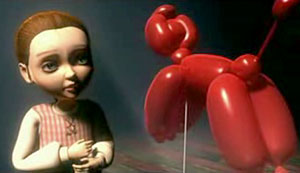 So he dematerialized it, & produced instead a red & yellow yoyo, which he then turns back into another balloon on a string. This time the girl is almost tempted, but not quite, & the clown is clearly losing patience. So he dematerialized it, & produced instead a red & yellow yoyo, which he then turns back into another balloon on a string. This time the girl is almost tempted, but not quite, & the clown is clearly losing patience.
He continues to perform tempting magic, each trick concluding with the offer of a balloon. An especially delightful balloon-animal -- a poodle that barks & wags its tail -- finally wins her over. The clown looks victoriously vicious & waves farewell as the girl embraces the balloon-puppy & is lifted into the air!
There's a little fillip at the end, & one is left with a fairly strong emotional response to this poetic expression of a child's near-death experience.
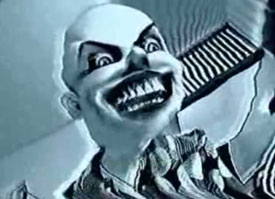 A 3-D animated student film, in Hebrew with English subtitles, Smile (2005) was made at the Bazalel Academi of Arts & Design in Jerusalem.
A 3-D animated student film, in Hebrew with English subtitles, Smile (2005) was made at the Bazalel Academi of Arts & Design in Jerusalem.
Apparently partly live-action thoroughly altered in-computer (though I am only guessing how the bizarre blend of realism & animation was achieved), Smile has an urban hipness to the design, with superb details & expressive faces.
A young man, Yuval, knocks on the apartment door of a young mother, Hagith, & her grown son, Oshik. After Hagith lets him in, Yuval momentarily converses with friendly vulgarity with his friend Oshik, who is trying to fix his mother's television.
Hagith then introduces Yuval to a friend from England, Nikomes, a sexy young woman lounging in an easy chair, with her leg in a cast, waiting for the television to start working.
The young man sits down near the beauty & asks, in English, "So, how did you break your leg?" He then unexpectedly perceives her as a hideous ghostly clown-like being with no hair, smiling hugely as she growls the answer, "By accident." Neither Oshik nor Hagith seem to see her as she really is!
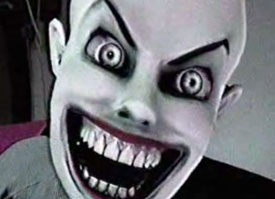 The apartment has a startling almost photographic realism to it, but when the fiercely smiling demon appears, the room loses most of its color & looks much less real. The apartment has a startling almost photographic realism to it, but when the fiercely smiling demon appears, the room loses most of its color & looks much less real.
After the first manifestation, Yuval is very freaked out, but remains as calm as he can. Nikomes now looks fine & speaks normally. Is he going mad?
The television begins to function & there's an old black & white silent horror film playing. Increasingly paranoid, Yuval's afraid to drink the coffee offered; he tries not to show his terror, as he doesn't know what's going on or if he can trust anyone in the room.
He expresses his desire that Oshik join him for a night on the town, though really he's trying to get his friend away from what he perceives as a dangerous situation. But Oshik has lost consciousness, as the coffee Yuval refused to drink had indeed been drugged.
"Leave him alone," says Hagith. "Let him sleep." Yuval refuses to believe there is anything normal about this & begins a very hostile argument with Hagith, who turns into a similar bald & ghostly clown-like being while she rails against him.
The Hagith-monster appears to bite Oshik's neck. He turns into one of the bald creatures as he awakens. Nikomes has revealed herself as well. Even the household cat is really one of these terrible things!
This is an an excellent piece of animation, telling a doomful mysterious horror tale. Visit www.lioninzion.com for more about this & other adult animation from Israel.
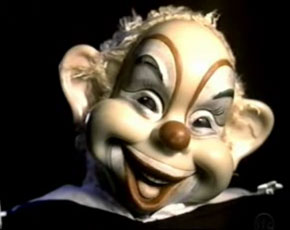 An eight & a half minute film self-defined as "an educational slide presentation by Tom E. Brown," Das Clown (1999) is comedy horror, & really quite funny.
An eight & a half minute film self-defined as "an educational slide presentation by Tom E. Brown," Das Clown (1999) is comedy horror, & really quite funny.
In an out of the way place there was a small antique shop run by a little old man, Mr. Higgins (Richard Goodman).
We hear the narrator John Popper clicking the slides one by one as he tells the tale, to an original score by Mike Franzman that captures a real combination of circus music & suspense movie soundtrack.
There's only a slight edge of the weird at first, as Mr. Higgins shows us, slide by slide, some favorite items around the museum-like shop. "And then there was Sparkles," notes the narrator, a clown doll smuggled into the country, handmade in Germany with a cloth body & a porcelain face.
Mr. Higgins loved Sparkles like a son, & wished the doll could come to life. Suddenly a gust of cold wind blew through the shop & a book called "Das Clown" appeared where it had not previously been.
The shopkeeper begins to read a horror story to Sparkles. In the midst of the tale magic words occur, & he innocently sounded them out.
Sparkles comes to life & kills Mr. Higgins with a replica medieval axe. Deputy Harland (writer-director Tom E. Brown) happens by & finds the corpse. Sparkles attacks the deputy with a sickle, but the deputy shoots him & Sparkles is again lifeless, pink blood seeping from his little body.
With the arrival of paramedics (Emily Popper & Jaye King), the bloody little doll leaps back to life & fetches a chainsaw, attacking the paramedics trying to saw through their ankles.
Deputy Harland is so scared he shows a white flag to Sparkles. Not only does Sparkles stop killing, but when they gaze into one anothers' eyes, he & the deputy fall in love. They got married, & today Sparkles & Deputy Harland live in the Castro District in San Francisco & jointly own & operate a trendy juice bar.
copyright © by Paghat the Ratgirl
|
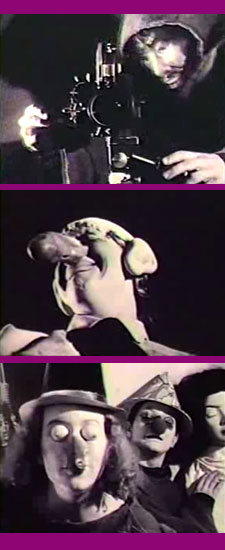

 Within that faith, the future coming of a master race of Bozos is a fundamental teaching, so unlikely as it seems, Let's Visit the World of the Future is a religious film.
Within that faith, the future coming of a master race of Bozos is a fundamental teaching, so unlikely as it seems, Let's Visit the World of the Future is a religious film. Everyone has their own assigned "unit for eunichs" which we might call bachelor apartments. Anyone who balks at the system in any manner is beaten by roving gangs of Bozos.
Everyone has their own assigned "unit for eunichs" which we might call bachelor apartments. Anyone who balks at the system in any manner is beaten by roving gangs of Bozos. When these offspring are awakened at age twelve, they immediately become effective laborers with twenty-hour workdays seven days a week.
When these offspring are awakened at age twelve, they immediately become effective laborers with twenty-hour workdays seven days a week.
 n 1980 there cearly was an audience, however small, that just wanted to see some girls' boobs then see the dirty sluts punished via brutal slayings -- & Terror on Tour was these pervs' idea of sexy.
n 1980 there cearly was an audience, however small, that just wanted to see some girls' boobs then see the dirty sluts punished via brutal slayings -- & Terror on Tour was these pervs' idea of sexy.
 So he dematerialized it, & produced instead a red & yellow yoyo, which he then turns back into another balloon on a string. This time the girl is almost tempted, but not quite, & the clown is clearly losing patience.
So he dematerialized it, & produced instead a red & yellow yoyo, which he then turns back into another balloon on a string. This time the girl is almost tempted, but not quite, & the clown is clearly losing patience.
 The apartment has a startling almost photographic realism to it, but when the fiercely smiling demon appears, the room loses most of its color & looks much less real.
The apartment has a startling almost photographic realism to it, but when the fiercely smiling demon appears, the room loses most of its color & looks much less real.